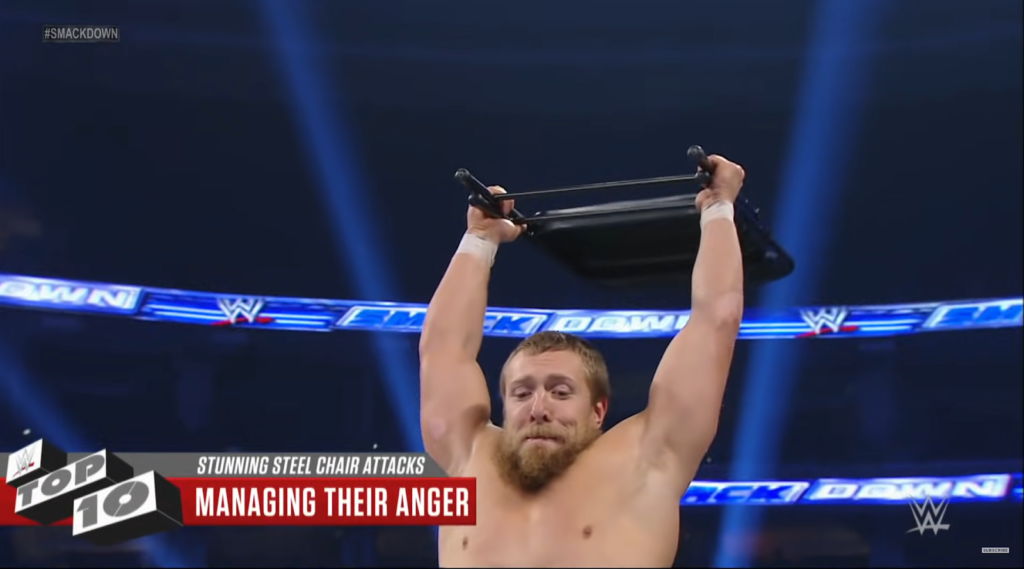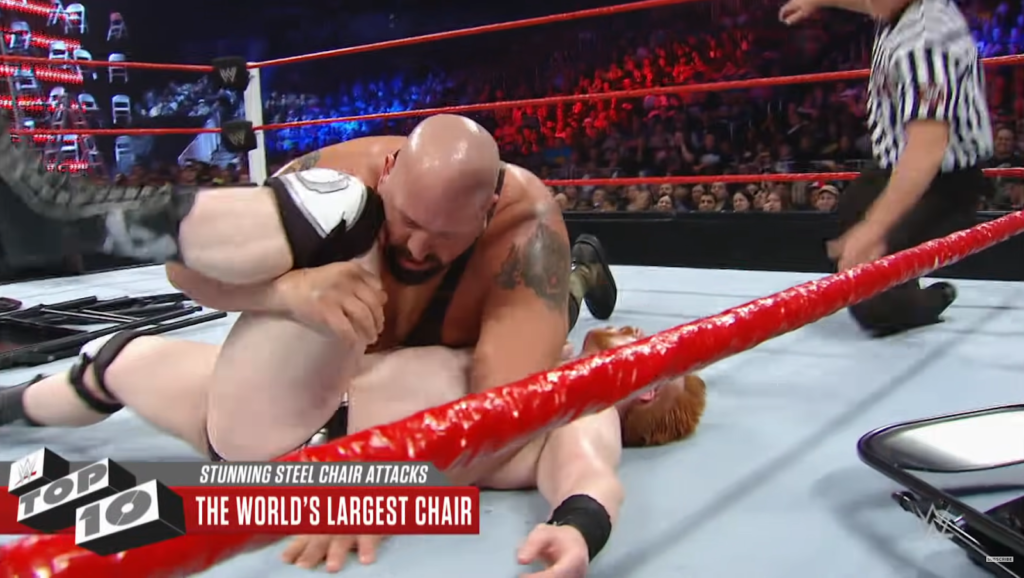We’ve witnessed WWE wrestlers employing “steel” chairs to pummel their adversaries to the brink of defeat. However, a blow to the head with a genuine steel chair would result in a severe traumatic brain injury. Hence, the question arises: What materials constitute the composition of WWE chairs?
The Composition of WWE Chairs
WWE chairs, often associated with steel, are predominantly crafted from aluminum. A metallurgical analysis report delves into these chairs, revealing that those labeled as ‘steel’ by WWE are primarily constructed using 92% aluminum, 6% tin, and 1% copper, alongside trace amounts of steel and tungsten.
Yet, the impact of being struck by a metal chair is undeniably substantial. Dive deeper to understand this, including insights into how WWE wrestlers shatter tables, the authenticity of bloodshed, and their strategies for evading visible bruises.
How Wrestlers Avoid Serious Injuries?
Ever wonder how WWE wrestlers seemingly shrug off chair shots without major harm? The secret lies in the chairs themselves – they’re typically crafted from thin, hollow aluminum. This unique composition, coupled with other factors, contributes to their safety.
- While the sight of a chair strike raises eyebrows, these chairs aren’t as menacing as they appear. The dramatic visual is enhanced by the chair’s lightweight aluminum construction, which is relatively soft and less robust;
- Adding to their safety, WWE chairs lack heft due to their hollow structure, ensuring only a fraction of metal contacts the grounded wrestler. Moreover, the wielding wrestler doesn’t exert maximum force; the illusion of a forceful blow is emphasized through sound effects;
- The hollow interior serves as a sound chamber, amplifying the noise and enhancing the theatricality. The chairs are deliberately engineered to bend upon impact with a wrestler’s body, like the head, minimizing potential harm.
While steel chairs would pose significant risks, WWE wisely opts for safer alternatives to prevent severe injuries. Despite the precautions, it’s important to note that being struck by a WWE chair isn’t devoid of discomfort. Wrestlers, dedicated professionals, endure such hits in pursuit of an engaging spectacle that captivates audiences with its exhilarating blend of athleticism and entertainment.
Table-Breaking in WWE Wrestling

In the world of WWE, the dramatic art of table-breaking is a spectacle that fans can’t get enough of. But have you ever wondered how those tables shatter so spectacularly? The secret lies in the technique employed by the wrestlers and the unique properties of the tables themselves.
Contrary to what might appear on screen, WWE tables are not crafted from solid wood. Instead, they are constructed from thin and hollow plywood, making them surprisingly fragile. To execute a successful table break, wrestlers aim for the table’s center, which happens to be its weakest point. This strategic targeting, coupled with the table’s inherent vulnerability, allows for a visually stunning yet safe maneuver.
Interestingly, the illusion of pain might not always match reality. While landing on a table might seem like a bone-jarring experience, the truth is that these tables are designed to break apart with ease. In fact, for a wrestler hurtling through the air, it’s often simpler to break the table upon impact than to attempt a delicate landing that avoids breaking it.
The wrestler’s body weight plays a pivotal role in this spectacle. By distributing the force evenly, the impact is transferred to the table, causing it to snap or the legs to collapse, while the wrestler emerges relatively unscathed. It’s a choreographed dance of physics and showmanship that never fails to captivate the audience.
To put it in perspective, imagine the way little kids in karate class can effortlessly snap a seemingly “thick” plywood board with a punch or kick. The WWE tables operate on a similar principle, designed to give way in response to a well-executed move.
Is Bloodshed Authentic in WWE Matches?
Bloodshed within WWE matches has undergone fluctuations between authenticity and fabrication. While genuine blood was frequently utilized, instances of simulated blood have also been observed. In 2008, Vince McMahon implemented a prohibition on both real and ersatz blood. Prior to this regulatory shift, a technique known as “blading” involved deliberate skin laceration to induce bleeding, along with the application of synthetic blood, all strategically employed to amplify the dramatic essence of the matches and boost ticket sales.
The transition to a more family-friendly presentation, often referred to as the PG Era, rationalized the imposition of these regulations. This change resonated with my own experiences of watching WWE during that period as a young viewer. The absence of explicit bloodshed provided a sense of relief, as the sight of blood was unsettling for many fans.
Nonetheless, instances of legitimate bleeding persist intermittently. The wrestling ring itself, replete with potentially abrasive elements like chairs, turnbuckles, tables, and stairs, can readily incite minor abrasions or cuts leading to bleeding.
- Balancing Dramatic Impact and Hygiene: It’s imperative to acknowledge that the presence of blood poses hygienic concerns. This pivotal consideration contributed to the decision to prohibit bloodshed within WWE events;
- A Nostalgic Glimpse Back: In an era preceding the shift to more restrained content, artificial blood was an instrumental tool in creating compelling narratives and augmenting ticket sales. The application of fake blood served as a popular technique to augment the theatricality of the matches.
As the trajectory of WWE’s approach to bloodshed has evolved, a delicate equilibrium between dramatic allure and viewer welfare has come into focus.
Why Don’t Wrestlers Suffer from Bruises?

Bruises are a rarity among wrestlers due to the scripted nature of their matches. The controlled nature of their actions minimizes the chances of impactful blows that could lead to bruising. Bruises generally emerge when blood vessels break in a confined area due to forceful impacts. Hence, maneuvers like slams and throws, common in wrestling, are unlikely to trigger bruise formation.
- WWE Wrestlers: Entertainers First: WWE wrestlers prioritize entertainment over actual combat. Their training encompasses executing staged punches, striking with open fists and limited force to prevent bruising;
- Strategic Slams and Bruise Prevention: When it comes to authentic slams, proper execution ensures even force distribution, thwarting the occurrence of bruising. The impact disperses across the body, preventing the concentrated force that could lead to bruise formation;
- Skin Tone and Concealment: The visibility of bruises is more pronounced on individuals with fair complexions, a fact highlighted by figures like Sheamus, whose bruises become apparent post-match. To maintain a polished appearance for stage and television, wrestlers sometimes employ makeup and spray tans to mask bruises, especially when they have multiple matches within a brief timeframe;
- WWE’s Simulated Spectacle: WWE’s appeal lies in its choreographed nature, where entertainment takes precedence over authentic combat. The absence of significant bruising aligns with this theatrical approach, and the use of simulated blood further accentuates dramatic moments;
- Occasional Realism Amidst Caution: There have been instances of legitimate injuries resulting in actual bloodshed, but the unsanitary and hazardous nature of such occurrences has led wrestlers to refrain from pursuing this route;
- Props and Impact Mitigation: The chairs and tables employed in WWE matches are designed from materials like aluminum and plywood, offering a balance between dramatic effect and safety. These props may enhance the spectacle but typically inflict minimal pain due to their composition.
In essence, WWE’s allure hinges on its orchestrated nature. Bruising is curtailed by design, while the integration of realism remains confined within controlled parameters to ensure safety and entertainment value.
Conclusion
The seemingly bone-crushing clashes witnessed in WWE matches are artfully constructed spectacles, where even the chairs employed to amplify the drama are meticulously designed to prioritize safety without compromising on the thrill. Crafted from a combination of lightweight yet durable materials such as aluminum and plywood, these chairs possess the ideal balance between visual impact and reduced risk of injury. The evolution of these props over the years underscores WWE’s commitment to providing audiences with captivating entertainment that doesn’t jeopardize the well-being of its performers.